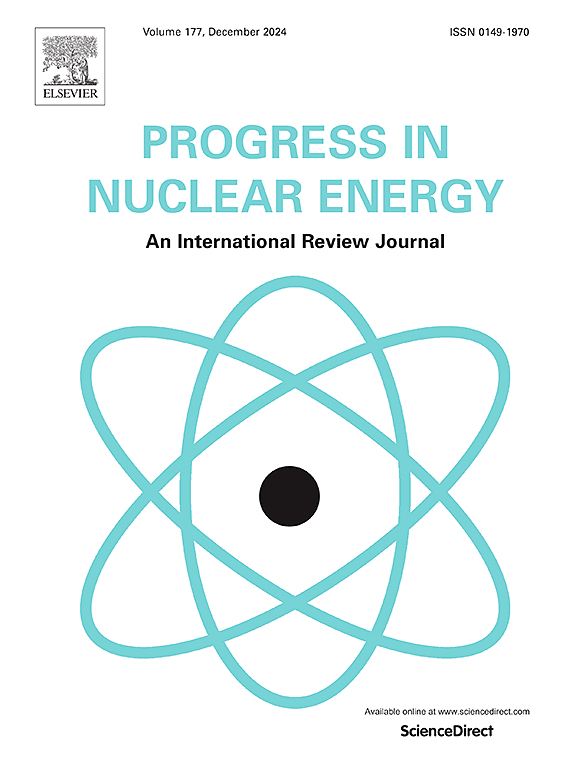典型事故下基于hpr1000的压制式安全壳系统短期放热减压系统研究
IF 3.3
3区 工程技术
Q1 NUCLEAR SCIENCE & TECHNOLOGY
引用次数: 0
摘要
为解决核电厂双层混凝土安全壳系统安全性与经济性的矛盾,本研究以中国第三代核技术为研究对象。基于HPR1000反应堆设计,提出了一种抑制安全壳系统,并对其在典型事故情景下的响应特性进行了分析。然而,对短期放热减压系统(SHRPRS)放热能力影响因素的参数化研究尚未开展。因此,本文研究了多功能池(MFP)的气体空间体积、降压排放管道的截面积和管道浸没深度等关键参数对系统抑制压力和储存不凝性气体能力的影响。此外,还探讨了不同安全壳体积下SHRPRS的配置方案,以解决超出设计基础事故(bdba)。结果表明,对于没有SHRPRS的机组,8.6万立方米和7万立方米的围堵容积符合BDBA缓解标准,而6万立方米和4.9万立方米的围堵容积不符合标准。对于配备SHRPRS的装置,适当的气体空间体积和管道截面积配置可以使所有四个密封容积(86,000 m3, 70,000 m3, 60,000 m3和49,000 m3)处理BDBA。本文章由计算机程序翻译,如有差异,请以英文原文为准。
Research on the Short-Term Heat Release and Pressure Relief System of HPR1000-based suppressive containment system under typical accidents
To address the contradiction between safety and economy in double-layer concrete containment systems for nuclear power plants, this study focuses on China's third-generation nuclear technology. Based on the HPR1000 reactor design, a suppression containment system was previously proposed, and its response characteristics under typical accidents scenario were analyzed. However, parametric studies on factors influencing the heat removal capacity of the short-term heat release and pressure relief system (SHRPRS) were not conducted. Therefore, this paper investigates the effects of key parameters—including the gas space volume of the Multi-Functional Pool (MFP), cross-sectional area of the depressurization discharge pipes, and pipeline submersion depth—on the system's ability to suppress pressure and store non-condensable gases. Furthermore, configuration schemes for SHRPRS under different containment volumes to address Beyond-Design-Basis Accidents (BDBAs) are explored. Results indicate that for units without SHRPRS, containment volumes of 86,000 m3 and 70,000 m3 meet BDBA mitigation standards, while volumes of 60,000 m3 and 49,000 m3 fail to comply. For units equipped with SHRPRS, appropriate configurations of gas space volume and pipeline cross-sectional area enable all four containment volumes (86,000 m3, 70,000 m3, 60,000 m3, and 49,000 m3) to handle BDBA.
求助全文
通过发布文献求助,成功后即可免费获取论文全文。
去求助
来源期刊

Progress in Nuclear Energy
工程技术-核科学技术
CiteScore
5.30
自引率
14.80%
发文量
331
审稿时长
3.5 months
期刊介绍:
Progress in Nuclear Energy is an international review journal covering all aspects of nuclear science and engineering. In keeping with the maturity of nuclear power, articles on safety, siting and environmental problems are encouraged, as are those associated with economics and fuel management. However, basic physics and engineering will remain an important aspect of the editorial policy. Articles published are either of a review nature or present new material in more depth. They are aimed at researchers and technically-oriented managers working in the nuclear energy field.
Please note the following:
1) PNE seeks high quality research papers which are medium to long in length. Short research papers should be submitted to the journal Annals in Nuclear Energy.
2) PNE reserves the right to reject papers which are based solely on routine application of computer codes used to produce reactor designs or explain existing reactor phenomena. Such papers, although worthy, are best left as laboratory reports whereas Progress in Nuclear Energy seeks papers of originality, which are archival in nature, in the fields of mathematical and experimental nuclear technology, including fission, fusion (blanket physics, radiation damage), safety, materials aspects, economics, etc.
3) Review papers, which may occasionally be invited, are particularly sought by the journal in these fields.
 求助内容:
求助内容: 应助结果提醒方式:
应助结果提醒方式:


